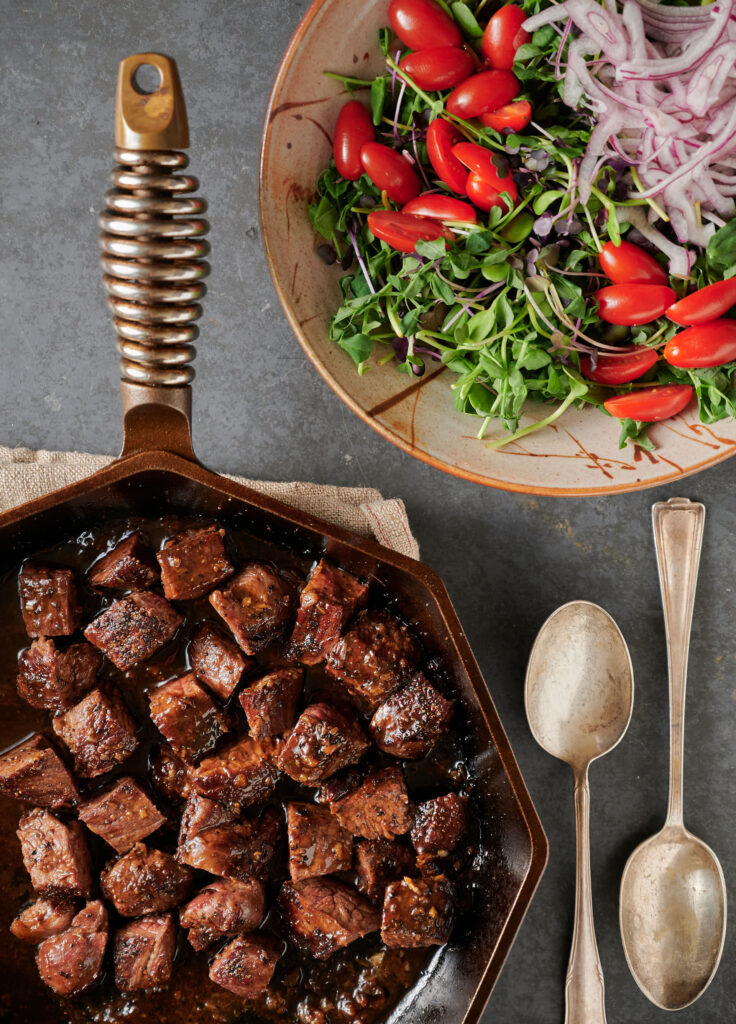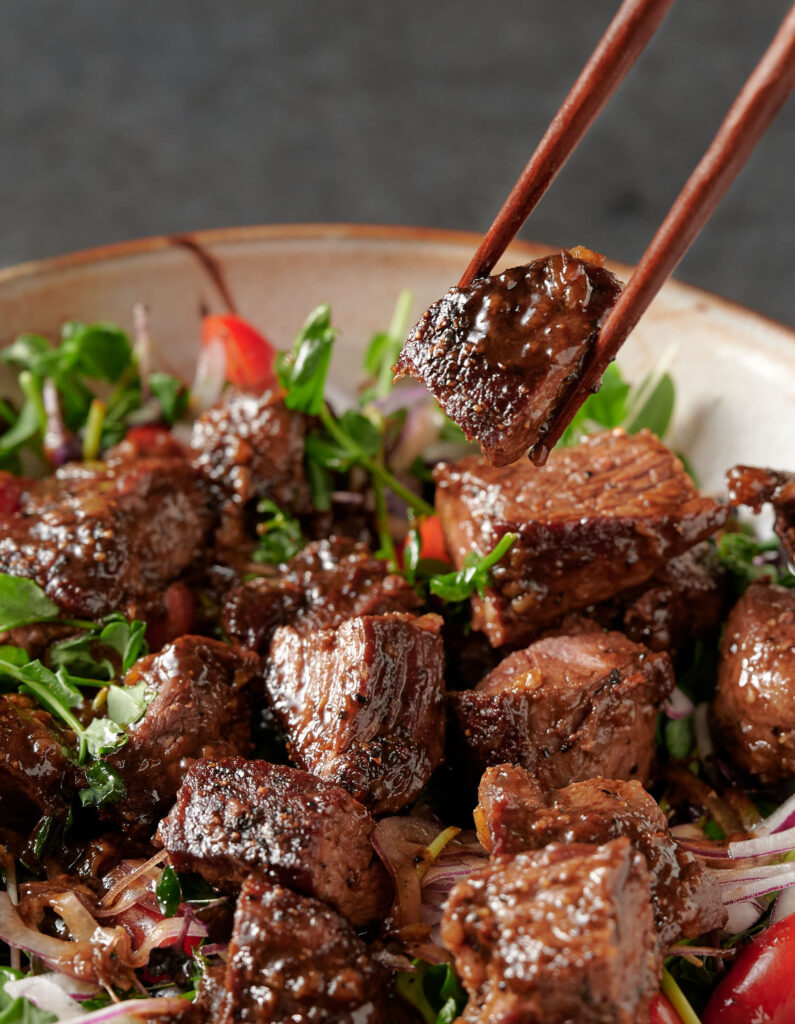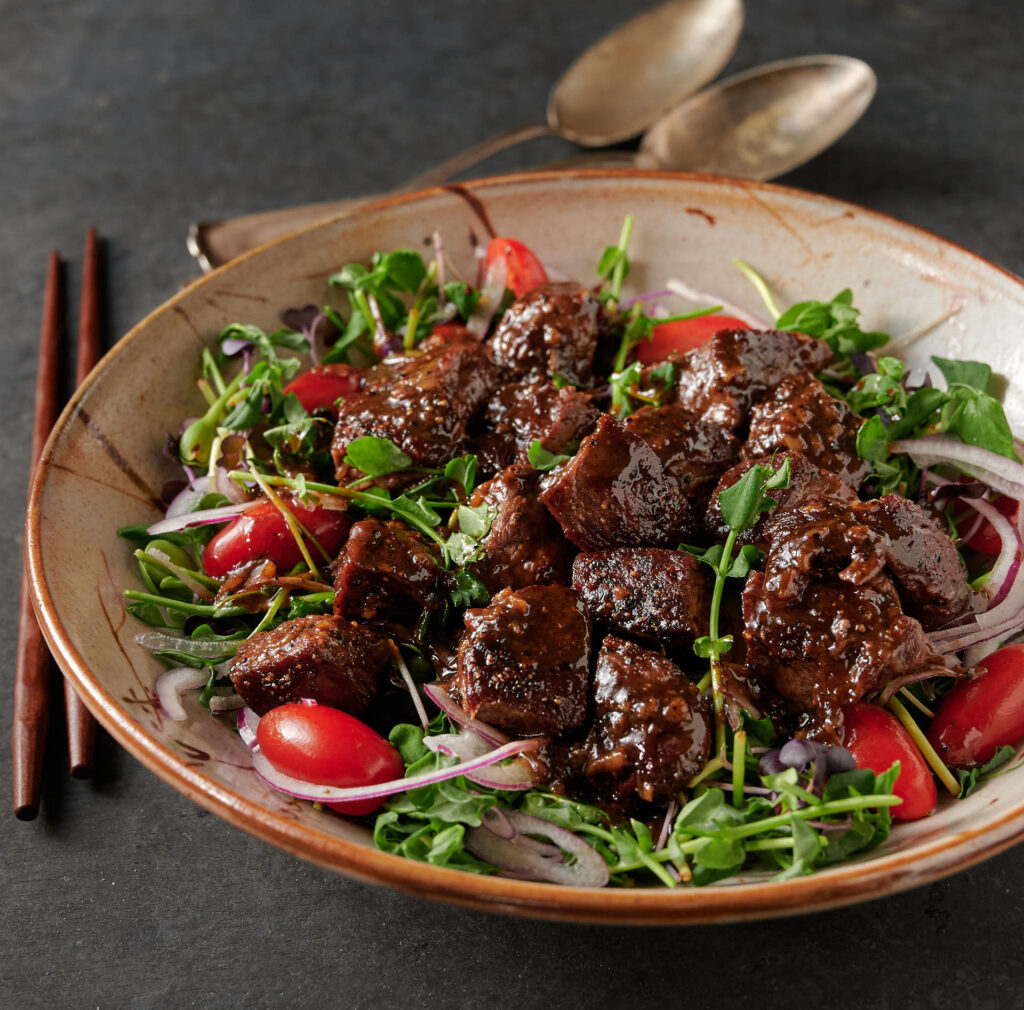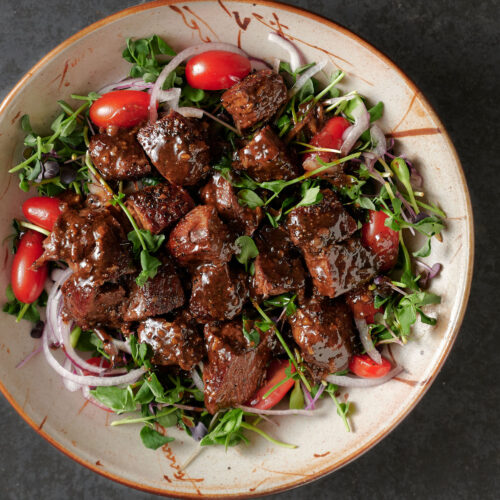Shaking beef – bo luc lac – is one seriously tasty composed salad. Think super-flavourful sauteed beef on fresh greens, onions and tomatoes.
Wonderfully browned bits of beef in a peppery, salty sweet sauce. That’s what this is. The sauce wilts the greens a bit and the whole thing just explodes delicious in your mouth.
If you are a fan of the whole warm/cold composed salad thing this could become your new go to dish.
Shaking beef doesn’t shake on the plate. That just sounds unappetizing when I write it down. It’s called shaking beef because of the way it’s cooked. Traditionally anyway.
You’re supposed to shake the pan as the beef cooks. To make sure each little bit of meat gets evenly browned. Which is great in theory. But I don’t think that’s the best way to cook it.

Shaking beef needs to be browned
That browning that you get when you fry beef? That has a name. It’s called the Maillard reaction. And that reaction is a wonderful, wonderful thing.
It’s food science. Chemistry. Amino acids and reducing sugars hit heat. And magic happens. Millions of new flavour compounds are created.
You don’t need to understand it. But you do need to believe in it. And you need to make sure it happens in your pan.
Which is why I don’t get a lot of recipes for shaking beef. I see marinate cubes of beef. Get them good and wet. Then dump it in a pan.
When I try that I get steamed beef. Grey beef with maybe a little browning If I cook the beef to death. Not what I’m after at all.
Wet, cubed beef is not good for Maillard. Think about overcrowding a pan when you are browning beef for stew.
You get browning. Eventually. Once all the liquid that’s been released from the beef evaporates. Not great. But you can get by because it doesn’t matter how long you have the beef in the pot. It’s stew.
The beef is going to get braised for hours. So you don’t have to worry about overcooking it in the pot. Thing is, it does matter for shaking beef.

Cook a steak – then make bo luc lac
When I want maximum Maillard I keep the beef in 8-10 oz size pieces. Steaks. And I salt at the last possible minute. Right before it goes into the pan.
Salting at the last minute is important. Think dry brining. As soon as you salt water is drawn out onto the surface of the meat.
That’s osmosis. More food science. The process reverses after a while. That’s how dry brining works. But you don’t want it in the pan while it’s wet. So salt at the last minute. You want as dry as you can get here.
You won’t get browning on all sides like you would with cubes here. That’s true. My thinking is that two sides done right is better than six sides of mediocre.
Plus you control how done the beef gets. Want medium rare? Stop at just before medium rare. Just remember an instant read thermometer is your friend here.
Once your steak is done to your taste, cut it into bite size chunks. You want comfortable bites here. Not big chunks. Unless you really want to practice your Heimlich manoeuvre I guess.

Add the sauce to the cooked beef
Even if you do decide to cut up your beef before you cook it please save the sauce for the end. Follow the recipe with a steak (better) or cubes (if you must) to maximize browning.
There’s another benefit to doing this way. When you cook beef in hot oil you get a fond. That brown stuff in the bottom of the pan? It’s gold. There’s all sorts of flavour there.
Cook the beef. Add the garlic and sweat it a bit. And then deglaze with the sauce. Scrape up that gold. Don’t leave it behind. Get that flavour into your dish.
Choice of oyster sauce matters for shaking beef
I may not be popular for saying this. But I really prefer Thai oyster sauce. For any recipe that isn’t Chinese anyway.
The flavour profile is different. I find it less salty. Less in your face. It doesn’t overpower. Just complements the dishes you use it in.
I couldn’t stand oyster sauce for years. Didn’t even stock it in my fridge. Until I discovered Thai oyster sauce. Now I always have it on hand.

Bo luc lac meets food science
This is shaking beef with a little food science thrown in. It’s a different approach for sure. Not your mom’s bo luc lac.
It’s how I like it though. I’m always after big, bold flavours. Try it. If you like it, let your mom know.
shaking beef – Vietnamese thit bo luc lac
Ingredients
The beef
- 1 lb beef ribeye or New York or filet mignon You want whole steak size pieces. Don't cut it into cubes yet.
- salt to season the beef
- 1 tsp black pepper you want to give the beef a liberal coating of semi-coarsely ground pepper (think butcher's blend)
- 3 cloves garlic – minced
- 2 tbsp vegetable oil plus a little more if the pan is dry when you add the garlic.
The sauce
- 2 tsp dark soy Thai sweet soy preferably
- 1 1/2 tbsp oyster sauce Thai preferably (strongly recommended really)
- 1 tbsp fish sauce
- 2 tbsp mirin
- 1-2 tsp sugar Or even more if you like things a bit sweet.
- 2 tsp sesame oil
The salad
- 1 tbsp rice vinegar to taste – this will be mixed with the hot sauce after you deglaze your pan.
- 3 cups watercress or baby greens of your choice.
- 1/4 cup red onion thinly sliced
- 1/2 cup cherry tomatoes cut in half (grape tomatoes are fine and so are thinly sliced regular tomatoes) – go with the best you can get
- a little drizzle of vegetable oil
Instructions
Do your prep
- Prepare your greens, red onion and tomatoes. Set aside.
- Combine the all sauce ingredients in a small bowl. You will be deglazing your pan with this sauce.
Cook the beef
- Pre-heat a heavy frying pan that will hold the steaks in a single layer over medium to medium high heat. Add the oil. Right before you start frying the steaks, season liberally with salt and pepper.
- Turn on your ventilation fan. This is going to smoke.
- Place the beef in the pan and fry around 3-4 minutes. You want a nice crust on the beef. This should get you to about medium rare. Depends on how thick your steaks are and how hot your pan is. I can't be more precise because I just don't know your specific details.
- Flip the steak and cook it another 3 minutes. Remove and let rest around 10 minutes. Check your internal temperature. 125F is rare. 130 is medium rare. Remove the pan from the heat.
- After the steak has rested for 10 minutes cut the beef into big bite size chunks.
- Return the pan to medium low heat. Keep an eye on it. You don't want your fond to burn. Once it is heated add the garlic and cook around 30 seconds.
- Turn the heat up and deglaze the pan with the sauce. Scrape up all that delicious brown gold and stir to get it to dissolve into the sauce.
- As soon as you have finished deglazing the pan turn down the heat to low. Taste it. Now start adding the rice wine vinegar. You are looking for a nice balance of acid and savoury. Creep up on it.
- When you get to the point you are happy with your sauce (now your vinaigrette really) return the beef to the pan. Heat through gently. You don't want it to cook more. Just warm it up.
- To serve spread your greens out on a plate. Top with onions and tomatoes. Drizzle with a bit of vegetable oil. Spoon the beef onto this mixture and drizzle with the sauce. Serve with lime wedges. Plate individually or as a communal appetizer.


